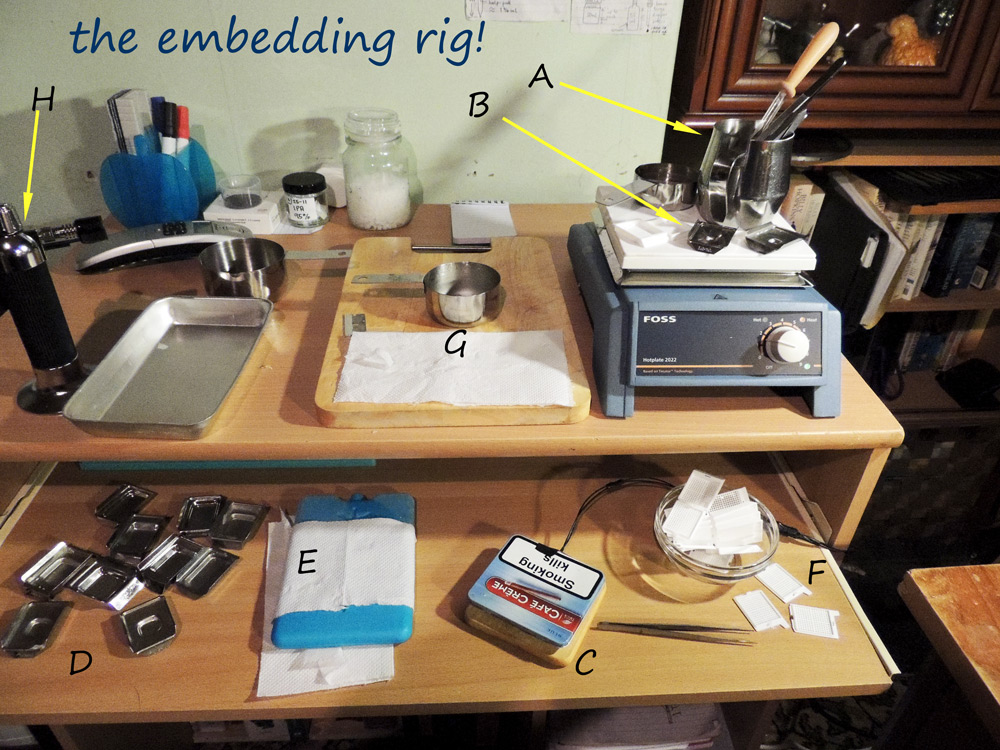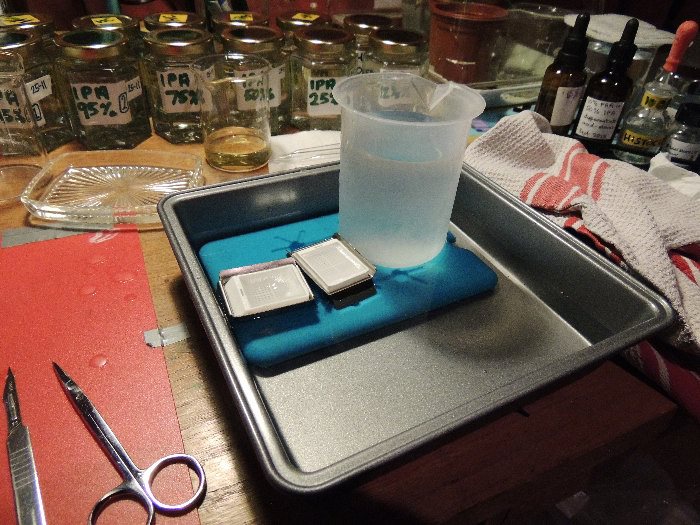Aha! an quick update, not much to report, the aloe finished it's dehydration this evening and moved into the first stage of
clearing, namely into 'Histoclear' overnight to begin the process of driving away the alcohol and replacing it with Histoclear as this is compatible with the wax used in the up-coming
infiltration stages... (in this role the clearing-agent is often referred to as a 'wax ante-medium' which is of course what it is).
Now, I'm not
really covering the progress of the
roots in these posts but can't resist mentioning them!

Sooo... meanwhile, across the bench to the world of Sonchus roots - the roots finished their infiltration today, meaning they were (hopefully!

)
totally infiltrated by wax, and water is now
completely absent from the tissues. The wax is right into the tissue and supporting it at the intra-cellular level - ready, after 'blocking-out', for the ravenous jaws of the 'Mighty Shandon'!
I cast a total of nine blocks this evening of the now ready root tissue - this went very well and the blocks look very promising indeed! The only problem may be that root tissue can be very hard/tough and has a tendency to become very brittle and problematic to section, but all factors being satisfactory there probably won't be any
serious trouble....gulp!

Here are a few pictures you may find interesting of the casting of the root tissue into wax blocks that will hold the tissue while they are sectioned!
This is my new small desk (£6.99 from a charity-shop!) set up for embedding (casting tissue into wax moulds/blocks)..

- ws_embedding_rig_1.jpg (273.15 KiB) Viewed 10852 times
The labelled parts are:
A = tools (forceps and a mounted needle) in the 'big' (stainless-steel milk jug) jug of molten wax ready for pouring and manipulation of tissues during orientation in mould - tools must be warm else the wax will simply stick to them as you pick up tissue - it can get ugly!

I use the long glass pipette that's standing in the wax to put the wax into the moulds - far more accurate and controllable than pouring the jug, and far cleaner - you need never spill a drop of wax using this..
B = moulds also warming on hotplate ready to receive wax and tissue..
C = my home-made 12V small hotplate (the making of this is covered in an earlier post) that if needed can fit under the stereo 'scope for manipulation of tiny tissues when orientating them in a mould.. Made after my little white coffee-cup warmer died.
D = various tissue-moulds ready to choose from..
E = cold-plate (an ice-block from the freezer - the tissue stops moulds slipping straight off!) to allow controlled cooling of mould from the bottom, aids tissue orientation as stiffening wax will start to 'grip' tissue and help to keep it in place if you're very careful!..
F = tissue cassettes (same as the ones that the tissue stays in whilst going through processing), these sit on top of the mould and as wax is added the cassette is 'set into' the wax and becomes the base of the wax-block when it's removed from the mould - this cassette-base fits nicely into the microtome's clamp and holds wax blocks securely, truly and reproducibly for sectioning - A superb system as made by 'Tissue-Tek' and used in labs all over the World..
G = a stainless-steel pot (actually a measuring-pot for cooking ingredients these come in sets of 5 for £3.50 and are perfect for wax and cassettes undergoing infiltration)..
H = gas-torch (used to burn the tops of food to make it look nice when cooking) that is great for lots of things, instant heat if things start to get sticky, tools that are too cold are heated in about 3 seconds! Wax-pots cam be re-heated if they get too cold etc - worth it's weight in gold - piezo-electric ignition can easily be used one-handed..
Anyway, moving on with the embedding, the tissue is still in the oven in molten wax, fully infiltrated and ready to embed into wax blocks - here's a pot taken out, with an opened cassette containing tissue in molten wax, sitting on the small hotplate seen above, ready for tissue pieces to be selected and placed into a wax-containing mould..

- ws_700x525_DSCN2740.jpg (77.88 KiB) Viewed 10850 times
Into a mould containg molten wax, onto the cold-plate as mentioned above to begin solidification..

- ws_700x525_DSCN2746.jpg (74.68 KiB) Viewed 10850 times
Behind this also on the cold-plate is a mould with the cassette placed on top and filled with wax as it will become the base of the block..
As soon as it's started to set and can be moved safely the mould/cassette combo goes onto another ice-pack sitting in water (held under by a beaker of water else the ice-pack will float!) that comes up the sides of the mould but not over the surface of the cooling and solidifying wax. Once the wax has formed a solid top it's moved from the ice-pack down into and under the surface of the chilled water to continue solidification..

- ws_700x525_DSCN2739.jpg (106.29 KiB) Viewed 10850 times
I made 9 blocks from the root tissue, here they are solidified, dried and ready to spend the night in the fridge before removal from the moulds tomorrow - they'll 'pop' nicely out of the moulds once solidified and cooled. Then I check them over and select a few for the initial stages of 'polishing the block' with the microtome before serious sectioning begins! Great fun, what an adventure each new set is!

- ws_700x525_DSCN2747.jpg (103.98 KiB) Viewed 10850 times
I seem to have included a lot about roots that I hadn't intended to - but as they're further along the processing protocol than the aloe they can serve as a sort of 'here's one I made earlier' example and I can show the stages without waiting for the aloe....
Hope you're enjoying this adventure as much as I am - eventually this story will reach the stage of staining, mounting and perusing a set of (hopefully nice) permanently-mounted slides ready to add to my as yet tiny collection - fingers crossed!


Back soon with more on the aloe and maybe some pictures of the root blocks and even some sections! Can't wait!
